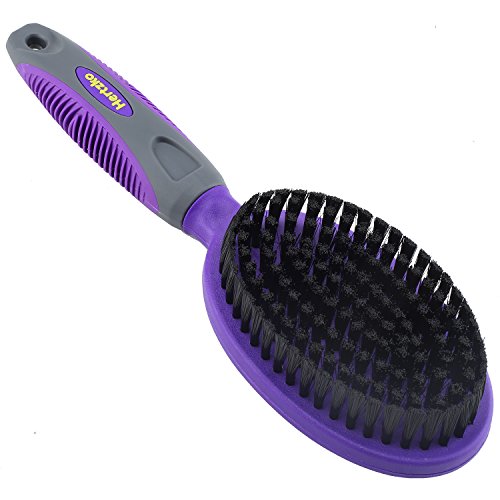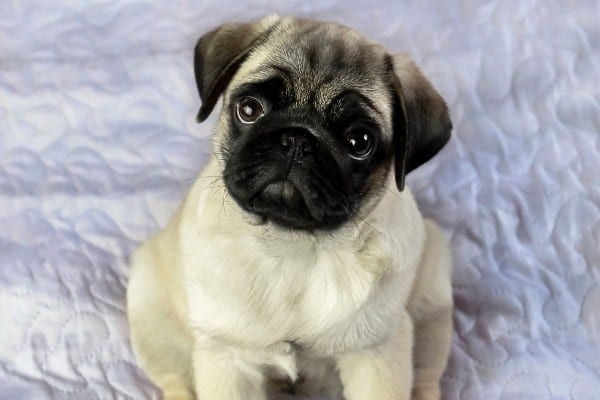
As an owner of a Pug mix myself, I can attest to exactly how wonderful a Pug cross can be.
I also know that to understand a Pug mix, it’s first important to understand the Pug as his (or her) influence will be evident in the offspring.
So, before diving into the most popular Pug mixes, we’ll first take a quick look at the roly-poly Pug to learn what you can expect in your future puppy.
If you’d rather skip down to view the Pug mixes, that’s fine too.
Pug Facts
History
The Pug was originally developed in ancient China close to 2,000 years ago. The earliest Pugs were known as Lo-sze or Foo Dogs and were treated like royalty.
The facial wrinkles were intentionally bred into the breed with a specific pattern in mind.
According to the American Kennel Club, the goal was to produce wrinkle patterns on the forehead to resemble the Chinese character for the word prince.
Thanks to DNA testing, we know that the Pekingese played a large role in creating the Pug.
It’s believed that in the 1500s Dutch traders were responsible for introducing the Pug to Europe, a move that forever altered the breed’s destiny.
Pugs were officially recognized by the American Kennel Club in 1885.
After a decline in popularity in the early 1900s, they quickly made a comeback thanks to the founding of the Pug Dog Club of America and the work of dedicated breeders.
Size
Pugs are sturdy, short-legged, barrel-shaped little dogs who should, according to breed standards, stand between 10 and 13 inches tall at the highest point of the shoulder (the withers) and weigh between 14 and 18 pounds at maturity.
Pugs do have a tendency to become overweight, so many will exceed the breed weight limit by quite a few pounds.
Males tend to be a little taller and heavier than females, and in fact, the AKC standard at one time allowed for male Pugs to weigh up to 20 pounds.
Colors
Both the American Kennel Club and the Pug Dog Club of America only recognize two colors in the Pug breed: fawn and black.
Fawn Pug

Black Pug
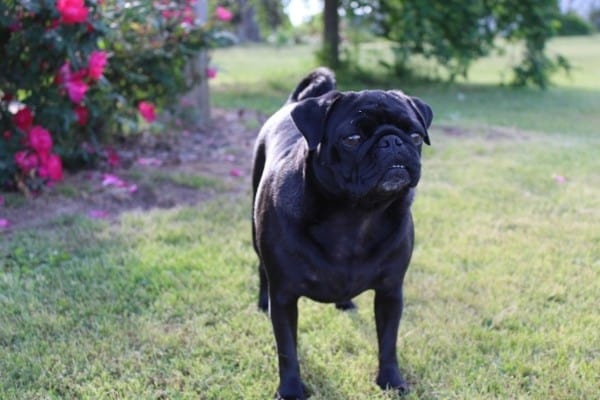
However, the fawn color can vary significantly – light cream, medium cream, gold, apricot, fawn, and even silver-fawn dogs can be registered as fawn, so the standards leave a lot of wiggle room in terms of color.
Fawn Pugs, regardless of shade, should have a deep black facial mask and black ears.
Some may also have a small patch of black, called a thumbprint, on the forehead and a line of black, referred to as the trace, running along the spine.
There are “rare” Pug colors gaining popularity, but it should be noted that these colors do not exist naturally in the Pug’s genetic makeup, and therefore any Pug sporting a color outside the breed standard is likely not a purebred Pug.
Some of the nonstandard colors you may find include:
- White.
- Brindle.
- Blue.
- Blue fawn.
- Merle.
- Blue merle.
- Chocolate.
- Panda.
- Black and tan.
- Pink.
- Chinchilla.
- Pied.
- Platinum.
Be sure to read our article on Pug colors for a more in-depth look at Pug colors and the controversy surrounding the unusual colors popping up in the breed.
Temperament
Pugs are perhaps one of the most delightful breeds around.
Aggression is practically unheard of in these roly-poly dogs, and as long as they are adored and well fed, they’ll be content.
With their sweet and gentle natures and trusting dispositions, all strangers quickly become friends, and this is true when encountering other dogs and animals too.
Pugs will do equally well with city or country life and don’t exhibit annoying behaviors, like excessive barking or digging, for which other breeds are known.
Pugs are naturally quite playful but also have a definite fondness for sleeping (and eating!).
Most are clowns at heart and will go to great lengths to obtain the attention they crave.
Many Pugs do have an obstinate side to balance out their laid-back characteristics. This stubbornness is most often seen in the form of selective hearing.
If your agenda just doesn’t quite line up with theirs at the moment, you will likely be politely ignored. In a Pug’s mind, this isn’t wrong, it’s just who they are.
They were bred to be treated like royalty, and the desire to be spoiled, catered to, and pampered remains strong in the breed today. Lorene Vickers-Smith says it best:
“They were bred to be pampered and watched over and that is what you must do.”
Exercise Requirements
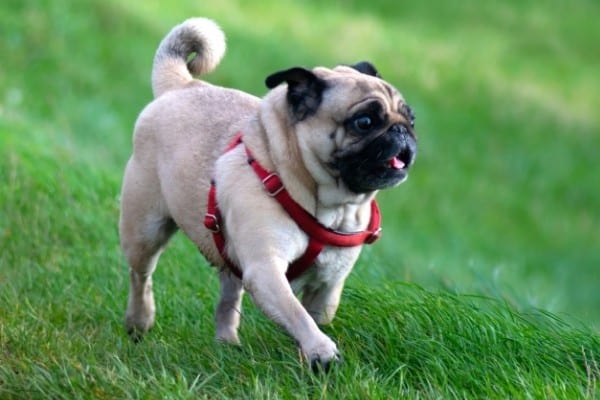
Because Pugs tend to pack on extra pounds easily, daily exercise is very important, though it can take many forms.
Generally, Pugs will need at least 45 minutes to an hour of physical activity each day.
This can be split into several sessions, and when temperatures are extreme, it is wise to do so.
Physical activity can consist of brisk walks, gentle hikes, games such as fetch, or free play outside with the kids or another dog.
If you’ve heard that Pugs are pure couch potatoes, know that this isn’t completely true.
They definitely appreciate lots of naps; in fact, if they aren’t playing or eating, chances are they’re sleeping.
However, Pugs have more energy than most people realize.
I know of two Pug brothers who will dash out the door, race each other round and round the yard at top speed for at least 20 minutes, take a short break to handle their business, resume the chase for another 15 minutes, and then be ready for a 30 minute walk around the neighborhood.
At the end of it all, yes, they enjoy a nice, long snooze, but an hour later, they’re ready to repeat their routine all over again or play tag with the kids outside.
So, a Pug’s energy level shouldn’t be underestimated, but you still need to keep an eye on them for any sign of respiratory difficulties or overheating.
Grooming
Pugs do shed, so brushing the coat a few times per week will help keep your home and clothing from being covered in shed hair.
Many Pug owners like to use a rubber grooming glove (I love this pair as they are great for working up lather at bathtime too), while others prefer a soft-bristled brush.
Either will work to remove dirt and loose hair from the coat, stimulate the skin, and distribute natural oils throughout the coat – it’s just a matter of personal preference.
The adorable facial wrinkles and other skin folds on the body will need to be checked and cleaned at least every other day.
Dog grooming wipes (like these alcohol-free wipes with aloe) work well for this.
Some owners dry wrinkles after cleansing and apply a bit of cornstarch or wrinkle balm areas prone to infection.
Some Pugs will need a bit of nose butter applied occasionally to heal chapped or cracked nose leather, but not all Pugs will experience this problem.
Like all dogs, Pugs should have their teeth brushed three or four times per week (this dental kit includes a dog safe toothpaste, toothbrush, and handy fingertip brush).
Bathing and clipping nails can be done less frequently. Once every four to six weeks is usually sufficient.
A Pug’s ears tend to stay warm and moist – the perfect environment for infections to develop.
They should be checked weekly for signs of irritation, inflammation, and infection and cleaned as needed with a pet ear cleansing solution (I like this one for my own dogs).
Health
Pugs have a brachycephalic facial structure that can lead to a number of health problems collectively known as brachycephalic obstructive airway syndrome, or BOAS for short.
You see, while the muzzle was shortened during the development of the breed, the internal structures remained the same length and were compressed.
Effects of this internal compression can range from fairly mild symptoms, such as snoring and snorting, to severe difficulty breathing and swallowing.
In extreme cases, heat exhaustion, collapse, stroke, or even death are possible.
In addition to issues related to BOAS, there are other conditions to which Pug’s seem to be predisposed:
- Defects and disorders of the circulatory system.
- Sensitivity to anesthesia and heat.
- Spinal conditions, such as hemivertebrae and constrictive myelopathy.
- Cancer, particularly of the skin and reproductive organs.
- Pug dog encephalitis (PDE).
- Bacterial, viral, or fungal infections.
- Obesity.
- Hip issues, such as hip dysplasia or Legg-Calve-Perthes disease.
- Allergies.
Understand that these conditions are merely possible, not probable, and there’s a good chance that a Pug may enjoy a lifetime of good health, particularly if purchased from a highly esteemed breeder.
You can learn more about common Pug health issues and obesity in our article here.
Breed Highlights
| Origin | China |
| Height | 10 – 13 inches tall at the withers |
| Weight | 14 – 18 pounds |
| Colors | Black and fawn (varies in shade) |
| Temperament | Playful, gentle, affectionate, loves people |
| Exercise needs | 45 – 60 minutes daily |
| Grooming needs | Fairly low, wrinkles must be kept clean |
| Shedding | Moderate |
| Hypoallergenic? | No |
| Health | Brachycephalic issues common |
| Lifespan | 13 – 15 years |
| Trainability | Moderate, can be stubborn |
| Good for families? | Yes |
| Good with other pets? | Yes |
Mixed Breed Dogs
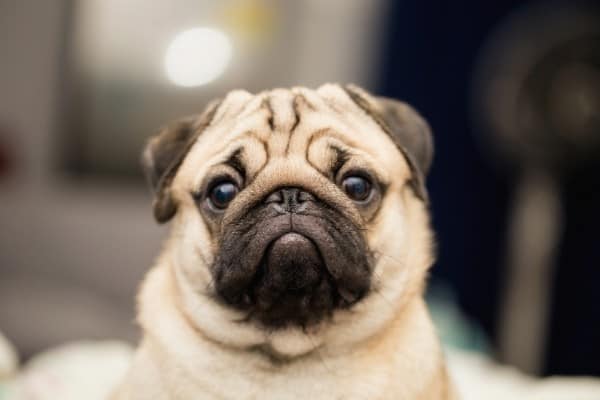
What to Expect With a Pug Cross
There will be a fair amount of unpredictability with a Pug crossbreed.
Some Pug crosses may closely resemble their Pug parent, some will look much like the other parent breed, and some will be a delightful combination of features.
Shedding may or may not be an issue.
Much depends on the characteristics of the non-Pug parent, of course, but generally you can expect a Pug mix to be friendly, affectionate, playful, and a little bit self-centered.
Like the Pug, a Pug mix will likely be strongly attached to his family and get along well with other dogs and children.
Colors, coat, size, and energy levels will vary based on the parents’ traits, though the Pug’s influence will likely be evident.
Why Are Some Mixed Breeds So Expensive?
The truth is that most mixed breeds are not expensive.
Animal shelters everywhere are overflowing with unwanted dogs who were most likely the result of accidental breedings and are often deemed “mutts.”
However, when two purebred dogs are intentionally bred with a specific purpose or goal in mind, you enter into the realm of “designer” dogs and expensive price tags.
Designer breeds have skyrocketed in popularity recently, so the demand often outweighs the supply.
Also, unlike common mutts, designer dogs have a pedigree, sometimes a very impressive one.
Breeders (responsible ones) perform genetic health screenings and practice generational breeding, both of which incur costs on their end.
Also, Cesarean sections are needed sometimes as well.
Charging high prices helps them recoup their expenses and ensures that the puppies will only go to homes that can afford to take good care of them.
Are Mixed Breed Dogs Healthier?
Many believe that mixed breeds possess what is known as hybrid vigor or heterosis.
This refers to a mixed dog’s tendency to experience fewer health conditions, generally be more robust, show improved quality, and have a longer lifespan than purebred dogs.
It is thought that the increased genetic diversity gained by combining two distinct breeds reduces the likelihood of pups inheriting predispositions to certain conditions and diseases from both parents.
Pros
In addition to the possibility of lower incidences of hereditary diseases, several other benefits may be associated with a mixed breed dog versus a purebred.
Often traits found in a certain breed that are considered negative, like excessive barking or the tendency to chase small animals, are not seen in the crossbred offspring, or at least not to the same extent.
The opposite effect is often noted as well.
Desirable traits, such as physical soundness, hypoallergenic properties, friendliness, and low shedding coats, may be strengthened, depending of course on the chosen breeds.
There is also a tremendous variety possible. Coat types, colors, size, and general appearance can vary greatly when two breeds are combined.
Even within the same litter, puppies may look incredibly different from one another.
For a breed with limited colors available, like the Pug, crossbreeding introduces many new possibilities and may, depending on the other breed used, provide additional benefits, such as reduced shedding or a longer muzzle to combat breathing difficulties so often seen in the breed.
Cons
The variety possible with crossbred, or designer, dogs could also be considered a disadvantage by those hoping for a certain look in their new puppy.
With some popular cross breeds who have been generationally bred for years now, breeders are often able to predict with relative accuracy certain traits, such as color, size, coat, and degree of shedding.
Other times, especially with some of the newer crosses, you really can’t be sure of what the puppies will be like.
Another negative possibility occurs when breeders forego health testing prior to breeding and both parent dogs carry genes that predispose them to genetic conditions and illnesses.
In this case, the crossbred puppies may be unhealthier than their purebred parents.
Another con to consider is the fact that many people are opposed to the practice of crossbreeding dogs, claiming that it contributes to the deterioration of the breed on many levels and is downright irresponsible.
As many compliments as you may get when taking a crossbreed out in public, you may likely receive an equal amount of criticism as well.
7 Cute Pug Mixes
Theoretically, a Pug can be successfully bred to any similarly sized dog, even larger breeds if artificial insemination is used.
Here, however, we’ll take a look at just seven of the more popular Pug mixes so you can get an idea of the variety possible.
Pug and Boston Terrier = Bugg

Known also as: Pugin, Bug, Boston Terrier Pug
Bugg Temperament
With a name like Bugg and two loving, friendly parent breeds, it’s no surprise that the Boston Terrier/Pug mix is an outgoing, affectionate dog.
Full of personality and prone to enjoying some serious playtime, a Bugg will delight any dog lover.
Pugins typically do quite well with other dogs and household pets and are a fantastic choice for families as they are tolerant, gentle, and patient with children.
Bugg Average Size
Buggs will be anywhere from 10 to 17 inches tall and on average weigh between 14 and 25 pounds. Adequate exercise and a healthy diet will keep them at a healthy weight for their size.
Bugg Colors
Most Buggs will be either black or fawn, though this of course will depend on the parents.
Boston Terriers are typically black and white in a “tuxedo” pattern but can also be black brindle, brindle, seal, or seal brindle mixed with white.
Any of these colors may show up in a Boston Terrier Pug mix, but if the Pug parent was a nonstandard color, that color may appear in the mix puppy as well.
A Bugg may be solid in color like a Pug or sport a bicolored coat like a Boston Terrier.
Bugg Exercise Needs
Some Buggs will be quite energetic and active and may need an hour or more of exercise each day split into several sessions.
Other Buggs may only need 30 – 45 minutes of physical activity per day to remain in good condition.
Bugg Trainability
Both Pugs and Boston Terriers are intelligent, quite devoted to their owners and seek to please people.
This typically means that training their offspring is easy, but remember that Pugs can be a tad stubborn at times, so you may need extra patience during training sessions.
Bugg Grooming Requirements
Buggs are quite easy to groom because of the short, sleek coat. They do shed, but a thorough brushing with a soft-bristle brush will keep the mess to a minimum.
Like all dogs, they’ll need routine ear cleaning, dental care, nail clipping, and the occasional bath.
Any skin folds or wrinkles should be cleaned and dried at least every other day.
Bugg Average Price
Prices will vary based on availability, demand, and location, but you can expect to pay between $600 and $1,800 for a Bugg puppy from a responsible breeder.
Pug and Pekingese = Puginese
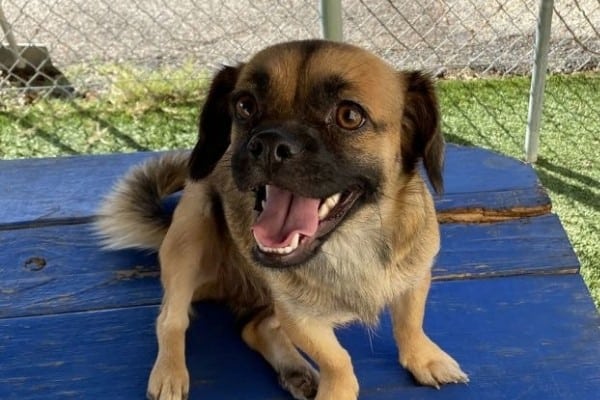
Known also as: Pekapug, Pekingese Pug mix
Puginese Temperament
Considering that Pugs and Pekingese have such different temperaments, it’s no surprise that the Puginese temperament can vary quite a lot.
Some may be super friendly and won’t mind being clowns (like a Pug), others may be dignified, wary of strangers and independent (like a Pekingese), and many will fall somewhere in the middle.
The Pekingese Pug mix may be a bit stubborn when it comes to training and may not be as patient with small children as a purebred Pug is.
Puginese Average Size
A Pekapug could be as short as 6 inches or as tall as 13 inches, but most will be 8 – 11 inches at the shoulder.
Weight can be hard to predict too. Anything in the 12 – 18 pound range is normal for a Puginese.
Puginese Colors
A Puginese may be fawn or black like a Pug or appear in any of the colors commonly found in the Pekingese breed, such as sable or black and tan.
Shades of fawn ranging from light to gold to reddish will be the most common colors seen in this small crossbreed.
Puginese Exercise Needs
Of course there will be exceptions, but most Puginese will remain fit with surprisingly little exercise.
About 30 minutes each day, broken into two sessions, is typically enough.
The exercise could be in the form of short walks, backyard playtime, or even indoor games.
Puginese Trainability
Some Puginese will take to training without any issues.
However, with parent breeds both known for having a hint of stubbornness or an indifferent attitude toward obedience, training a Pekingese Pug crossbreed may be slightly challenging at times.
Consistency and positive reinforcement will be the best approach.
Puginese Grooming Requirements
Puginese with a short, smooth coat like a Pug will only need a light brushing a few times each week to keep shedding manageable and the coat healthy.
Those with a medium to long coat more similar to that of a Pekingese will require more frequent, thorough brushings to prevent the long hair from matting.
Long coats can be trimmed to make them more manageable, but know that routinely shaving the coat can permanently ruin it.
Routine bathing and ear, nail, wrinkle, and tooth care will be necessary as well, of course.
Puginese Average Price
There aren’t a lot of Puginese breeders out there, and it may take some searching to find a puppy.
When you do find a responsible breeder, be prepared for a cost of around $1,000 and to be placed on a waitlist for the next available litter.
Pug and Poodle = Pugapoo

Known also as: Pugdoodle, Pugpoo, Pugadoodle, Pugoodle
Pugapoo Temperament
Most Pugapoos will be the ideal combination of the Pug’s sweet, loyal, easy-going characteristics and the intelligence and high spirits of the Poodle.
Expect a Pugapoo to be fun-loving and enthusiastic, good with children and pets, people oriented, and sweet natured.
Some Pugapoos may have a tendency to bark more than necessary if they take after the Poodle, but this can be controlled with training.
Pugapoo Average Size
Pugapoos resulting from the breeding of a Pug and Toy Poodle will remain on the small side, averaging less than 10 inches tall and weighing under 10 pounds.
However, Pugapoos with a Miniature Poodle parent can be expected to grow to about the same size as a purebred Pug.
Pugapoo Colors
Poodles come in a wide array of colors, and any of them may show up in the Pugapoo as well.
Anything from white to apricot, red, silver, or black, or even a combination of two colors is possible, or a Pugapoo could be colored the same as his Pug parent.
It all depends on which dominant color genes are inherited.
Pugapoo Exercise Needs
Pugapoos are usually active and energetic without being hyper.
Most Pugapoos will need around 45 minutes or so of daily physical exercise, broken into two or three periods.
Some may zip around during free play and get all the exercise they need, and others will need a bit of encouragement to get moving; it depends on which parent influenced the Pugapoo more heavily.
Pugapoo Trainability
With the right motivation, Pugapoos typically are easy to train, especially if they inherited their Poodle parent’s high intelligence.
Those who are a bit more self-focused, thanks to their Pug background, may need some extra patience and repeated practice before catching on to a new command.
Pugapoo Grooming Requirements
Some Pugapoos will have a coat very similar to that of a Pug and will only need an occasional brushing.
Other Pugapoos will have a Poodle-like coat that will require frequent brushings and routine trims.
Still other Pugapoos will have a combination coat with longer hair on the head or back and shorter hair everywhere else.
For these Pugoodles, brushing needs will be fairly minimal, similar to those with a short Pug coat.
Ear, dental, wrinkle, and nail care will be the same regardless of coat type, but bathing will be more frequently needed for Pugapoos with a long, curly, or wavy coat.
Pugapoo Average Price
Like many Pug crosses, Pugapoos are usually priced around $1,000.
Backyard breeders may charge as little as $300 – $400, but Pugapoos whose parents have an impressive pedigree may cost $1,500 or much more.
Exceptionally pretty pups may have a higher price tag as well.
Pug and Beagle = Puggle
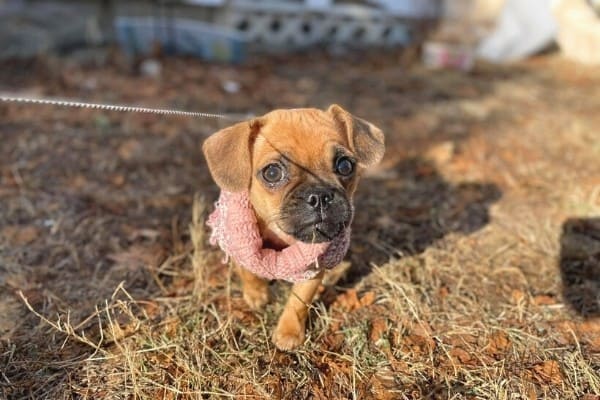
Known also as: Buggle, Beagle Pug mix, Peagle
Puggle Temperament
Puggles are playful, affectionate, outgoing, and charming in every way.
As Beagles are often described as being a “merry” breed, it’s not surprising that Puggles too are happy-go-lucky dogs content as long as their basic needs are met and they are given plenty of attention and love.
Some Puggles may have high prey drive or a tendency to bark (or howl) if they take after the Beagle side.
Stubbornness can be an issue during training (or whenever the mood hits), but persistence on your part can overcome this quality in time.
Puggle Average Size
Puggles can range anywhere from 10 – 15 inches tall and will typically weigh between 14 and 30 pounds.
Some Puggles may fall outside these norms, but you’ll find that because the Pug and Beagle are quite similar in size, most Puggles will adhere to these averages.
Due to their Pug heritage, care must be taken to ensure obesity does not become an issue.
Puggle Colors
Though most Puggles will be a fawn or tan color, a vast array of other colors are possible.
Thanks to the Beagle’s contribution, a Puggle can be red, lemon, black, blue, brown, or one of these colors combined with white.
The classic tricolor Beagle combo is another possibility as are various shades of the aforementioned colors.
Puggle Exercise Needs
Most Puggles need a total of 45 minutes to one hour of exercise daily.
This may be broken into several sessions throughout the day, and many Puggles will meet their activity needs on their own if engaged frequently in backyard play with the kids.
Others will need structured physical activity in the form of walks, games of fetch, or other directed play.
Puggle Trainability
With the proper techniques employed (i.e., lots of positive reinforcement, patience, and consistency), Puggles can be trained for a variety of commands.
Because both parent breeds are known for being a bit opinionated at times, stubbornness may be a problem occasionally, so it’s important to keep training sessions brief, engaging, fun, and rewarding.
Puggle Grooming Requirements
Puggles will have a short, smooth coat that only requires brushing with a soft-bristled brush or grooming glove a few times per week and a bath every month or so.
The floppy ears should be cleaned every few weeks, and any wrinkles present will need cleaning every other day.
The teeth should be brushed three to four times each week, and the nails will need trimming about once per month.
Puggle Average Price
Due to their reputation as ideal family dogs, Puggles tend to cost a bit more than other popular Pug mixes.
Expect to pay $800 – $1,800 for a Puggle from a reputable breeder.
Trendy colors are often priced more exorbitantly than the more commonly seen colors in this crossbreed.
Pug and Cocker Spaniel = Cocker Pug
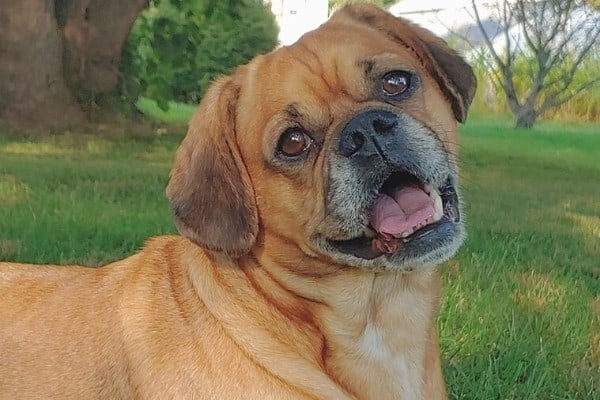
Known also as: Cock-a-Pug, Cocker Spaniel cross Pug, Pug Cocker, Cocker Spaniel Pug mix
Cocker Pug Temperament
Cocker Pugs have a sweet disposition, even temperament, and are generally happy, easy-going companions.
They are exceptional family dogs and get along well with household pets too.
Cocker Pugs are loyal and have a great love for their families. Aggression is practically nonexistent with these gentle, affectionate mixes.
Cocker Pug Average Size
Because of the Cocker Spaniel’s larger size, most Cocker Pugs will be significantly bigger than a purebred Pug.
They can range from 12 – 16 inches tall at the withers and may weigh anywhere from 15 – 30 pounds. Males will tend to be taller and heavier than females.
Cocker Pug Colors
The color possibilities with a Cocker Pug are truly varied.
Although the Pug is most commonly seen in fawn or black, Cocker Spaniels come in many colors, including brown, buff, red, cream, and silver.
These colors may be in a roan coat or may appear in combination with one or two other colors.
In a Cocker Pug, any of these colors are possible, depending on the genes carried by the parents.
Cocker Pug Exercise Needs
Many Cocker Pugs will only need roughly 45 – 60 minutes of daily exercise to stay fit and at an acceptable weight.
Cocker Pugs who tend to take after the Spaniel parent may be a bit more energetic, but hyperactivity should not be an issue.
A brisk walk or playtime outdoors a couple of times per day are ideal activities for using up energy and keeping them out of trouble.
Cocker Pug Trainability
Cocker Spaniels were originally bred to be highly trained hunting dogs and thus are quite intelligent and eager to please their owners.
Cocker Pugs often exhibit the same qualities and train easily.
On average, this Pug mix will be less of a challenge to train than other popular Pug mixes.
Cocker Pug Grooming Requirements
Most Cocker Pugs will inherit a coat similar to that of their Spaniel parent.
Length can vary from medium to long, and the coat is usually silky and straight, though some waves may be found on the legs and ears.
A thorough brushing several times per week will prevent mats from forming and reduce the shed hairs found in your home.
A trip to the groomer every six weeks for a trim will make coat care more manageable.
Any facial wrinkles will need cleaning every other day, and routine tooth brushing should not be neglected.
Like with all dogs, the nails will need a monthly trim, but this mix may need extra attention when it comes to the ears.
Cocker Pugs with long ears will be prone to ear infections, so a weekly ear exam and cleaning is important.
Cocker Pug Average Price
This is another Pug mix that may be hard to find in your area. When Cocker Pugs are available, prices are usually close to $1,000.
Puppies with exceptionally pretty coats or colors may be closer to $1,500, and those from backyard breeders may be as little as $500.
Pug and Chihuahua = Chug
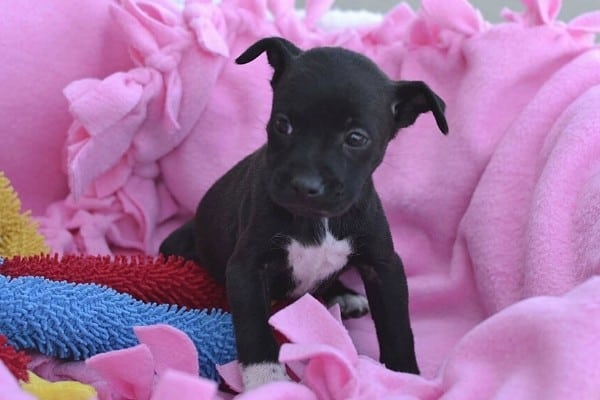
Known also as: Pughuahua, Chihuahua Pug mix, Pug Chihuahua mix
Chug Temperament
As you can imagine, combining two breeds with such vastly different temperaments can lead to a high variability in the Chug’s temperament.
Some Chugs will be very sweet, friendly, and playful, like a Pug, and other Chugs will be more like a Chihuahua with a feisty, wary, confident, bossy personality.
Most Chugs, however, will have a nice combination of the best temperament traits from both parents.
Chug Average Size
The majority of Chugs will be much smaller than a standard Pug. Most will be less than 10 inches tall at the shoulder and weigh less than 14 pounds.
Due to the size differences of Pugs and Chihuahuas, breeding is sometimes difficult.
Large male Chihuahuas are often used to sire litters, so few Chugs will be the size of a standard Chihuahua.
Chug Colors
Though many Chugs will be fawn or black like Pugs, the Chihuahua adds many other coat color possibilities.
Chocolate, cream, red, gold, silver, or a mixture of colors may appear in a litter of Chugs with each puppy being totally unique in shading and patterns.
Even brindle and sable patterns and spots are possible in a Chug.
Chug Exercise Needs
Exercising a Chug doesn’t require too much effort as most will be satisfied with two 30 minute walks or play sessions each day.
Lazier Chugs may need some encouragement to ensure they get enough physical activity to stay fit and trim.
More energetic Chugs will often have energy to spare even after two periods of exercise and may often engage in “zoomies” or free play to burn off the excess.
Chug Trainability
Chugs can be successfully trained, but it’s important to start early and ensure that socialization occurs in conjunction with training.
If a Chug has strong Chihuahua tendencies, he may be quite excitable and easily distracted during training sessions.
Both Chihuahuas and Pugs can be headstrong about obedience, so diligence, patience, and consistency, along with plenty of positive reinforcement, will aid the training process tremendously.
Chug Grooming Requirements
Most Chugs will have a short, smooth coat that only needs a light brushing a few times per week to remove debris and loose hair.
If a Chug’s sire was a long-haired Chihuahua, the coat may be softer and a bit longer. This Chug will require more frequent brushing to remove tangles.
Chihuahuas are prone to dental issues, so routine dental care should be a priority, but as far as ear, wrinkle, and nail care are concerned, the requirements are the same as for any other Pug mix.
Chug Average Price
Most Chugs cost less than $1,000 with some priced as low as $300 – $500.
However, there aren’t a lot of breeders currently focused on breeding Chihuahua Pug mixes, so available Chugs can be difficult to find.
When you do locate a good breeder, be prepared for a wait as most will only plan one or two litters per year.
Pug and French Bulldog = Frug

Known also as: Frugg, French Bug, French Bulldog Pug mix, Pug French Bulldog mix, Frenchie Pug
Frug Temperament
Frugs, like both Pugs and Frenchies, are typically easy going, loving, sweet, and friendly.
They usually do quite well in multiple-dog households and are gentle and patient with children.
Aggression is very rarely seen, and they easily make friends with new people and pets.
A bent toward stubbornness is possible, but on the whole, a Frug is an agreeable little dog who adores his family and loves attention.
Frug Average Size
Frugs are typically 10 – 13 inches tall, and most Frugs will wind up at around 20 pounds at adulthood.
However, weight can fluctuate greatly from dog to dog.
Frugs can take after the Pug parent and weigh as little as 14 pounds or inherit size from the French Bulldog and weigh as much as 28 pounds.
Frug Colors
French Bulldogs, according to breed standards, should be white, cream, fawn, or a combination of these colors.
However, as with Pugs, nonstandard colors often show up, and thus, Frugs have the possibility of a wide range of colors.
Typically though, a shade of fawn is the most common.
Frug Exercise Needs
Expect a Frug to need about 45 minutes of physical activity per day, broken down into several short periods.
Frugs will have the compressed muzzle common to both parent breeds, so exercise will need to be closely monitored to prevent issues such as heat stroke or inability to breathe normally.
Frug Trainability
Training a Frug is certainly achievable, but will require some effort.
With two parent breeds who have a reputation for a “free-thinking” outlook, Frugs may be a tad challenging to train, especially for those with little experience.
Both Pugs and Frenchies are highly motivated by food, so use this to your advantage when training.
Frug Grooming Requirements
Brushing needs for this cute Pug mix are minimal – just a few times per week. A grooming glove or soft-bristled brush is perfect for the job.
All skin folds on the body (including the tail pocket if present) will need cleaning at least every two days.
Ears should be cleaned every couple of weeks, and once a month or so a bath and nail trimming will be required.
Frug Average Price
Frugs have definitely found their place in the world of designer breeds and are usually more expensive than other Pug crosses.
$1,250 is at the lower end of the price range, and Frugs priced between $2,000 and $3,000 are common.
Unusual colors or markings may drive the price up even further.
Pug Mix Puppy Care
A Pug mix has the same basic needs as any other puppy:
- Lots of attention and love.
- A balanced puppy food appropriate for their size.
- Proper socialization practices.
- Training from an early age.
- Supervision.
- Age-appropriate physical activity.
- Protection from larger animals.
Because Pug mixes are on the small side, you’ll need to be diligent when it comes to keeping your little guy safe.
They can be accidentally stepped on or tripped over, fall off of furniture and be injured, can wiggle through small openings, swallow small objects, etc.
When you aren’t available to keep a close eye on your Pug mix pup, putting him in his crate for a snooze will keep him safe and give you some piece of mind.
Though not all Pug mixes will have shortened muzzles, many will.
For those with brachycephalic features, you’ll need to get in the habit of watching for breathing trouble and symptoms of overheating, as either issue could be life threatening.
Limit exercise to early mornings or evenings during the summer, and always have fresh cool water available.
Another aspect of Pug mix care that should quickly become routine is keeping the wrinkles clean and dry.
Bacterial and yeast infections can easily occur in the warm, moist skin folds and can lead to recurring dermatitis.
At minimum, all body wrinkles should be cleansed and dried every other day, though some dogs will need daily care.
Is a Pug Mix Right for Me?
A Pug mix isn’t right for everyone.
They aren’t large dogs, certainly don’t make good guard dogs, and may have issues keeping up with active owners.
They can suffer from brachycephalic problems and can vary greatly in appearance and temperament.
However, for those who love the Pug’s easy-going style and clownish antics, a Pug mix may be an ideal choice.
A Pug mix may be right for you if you enjoy the unexpected and want a dog who:
- Adores being with people.
- Is trustworthy and gentle with children.
- Gets along well with other animals.
- Is not aggressive.
- Loves to play and be the center of attention.
- Doesn’t require extensive exercise or grooming.
- Loves to snuggle and nap.
- Does very well in apartments.
- Good for first-time owners.
- Comes in many colors and patterns.
- Is loyal and adaptable.
The list of the benefits of owning a Pug mix could go on and on, but you get the idea.
Related Questions:
Is a Pug a good family dog?
Pugs can be the perfect addition to a family as they absolutely adore people, are wonderful with children, are not aggressive or overly delicate, and don’t take up too much space.
They’ll bond strongly with each member of the family and won’t mind a bit dishing out lots of snuggle time and playtime bonding opportunities.
Are Pugs Hypoallergenic?
Pugs are not considered to be hypoallergenic.
Though they do not shed heavily, Pugs do shed, and their dander, saliva, and urine contain proteins that trigger reactions in those with dog allergies.
A Pug/hypoallergenic dog mix, like the Pugapoo, may or may not be hypoallergenic, depending on which parent the mix takes after for hypoallergenic qualities.
Sources:
https://www.pugdogclubofamerica.com/pug-history.html
https://www.akc.org/expert-advice/lifestyle/things-you-didnt-know-about-the-pug/
https://www.pugdogclubofamerica.com/get-to-know-pugs.html
Image credits: Kristen Lumsden, Samantha Brower, Marky Lynn Quayle, Stephanie Keeler, Otis the Cocker Pug, Noah’s Hope Animal Rescue, Oh My Pug
Last update on 2024-04-25 at 00:47 / Affiliate links / Images from Amazon Product Advertising API


